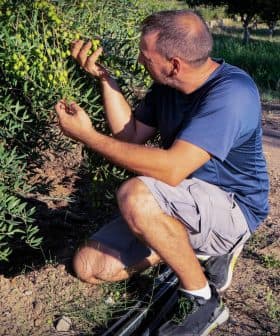Community Milling in California: Small Growers Encouraged to Reserve Early

Community milling days in California allow small olive growers to celebrate the harvest and create high-quality olive oil, similar to traditions in Mediterranean villages. The events, hosted by farms like Trattore Farms and McEvoy Ranch, provide an opportunity for growers to learn about olive oil production, share their olives, and enjoy the fruits of their labor with friends and family.
California community milling days are a way for small olive growers to celebrate the joys of the harvest and produce exceptional homegrown olive oil.
The days are similar to those in small villages in the Mediterranean, where all the villagers bring olives to the olive mill in the town center.
It is a day to celebrate the fall harvest and to bring all our small, local growers together to create a truly unique and delicious community blend of Olio Nuovo.
“2022, for some, was a very tough harvest; many growers found their crops to be quite light,” Mary Louise Bucher, a master miller and owner of Trattore Farms, told Olive Oil Times. “Being an alternate bearing crop, a lot of our customers are looking forward to a greater abundance of olives this 2023 harvest.”
Community milling is a popular tradition at Trattore Farms. “The very wet winter and heavy rains in Northern California have delayed things, so we expect the harvest to begin late and run later into the winter than normal,” Bucher said.
See Also:California Producers Keep Olives and Workers Safe in Record Heat“The community milling dates are October 29, November 12 and December 3,” she added. “We may add a fourth community milling date later in December to accommodate this delayed season and help our customers with later harvests.”
Community milling offers a time to gather with neighbors and celebrate the harvest. At Trattore Farms, community milling customers and club members are welcome to join the festivities – with or without olives.
With mills across the state offering their services, community milling gives hobby growers a chance to learn more about olive oil production and taste the fruits of their labor.
“We offer community milling day each year for olive growers who have less than 1,000 pounds (450 kilograms). Some people come with a few buckets; others arrive with a truckload,” Charles T. Crohare, owner of The Olivina, told Olive Oil Times.
Olivina is family-owned, established in 1881, and produces extra virgin olive oil from Mission, Arbequina, Lucca, Frantoio and Picholine olives. The company uses a state-of-the-art Italian-made Alfa Laval three-phase olive mill.
The milling process needs a minimum of 1,000 pounds to operate effectively. Growers are welcome, whether they have one or two trees and as little as a couple of pounds (about 1 kilogram) of olives.
“McEvoy hosts one community mill day each fall — and it is an incredibly fun day,” Samantha Dorsey, the president of McEvoy Ranch, told Olive Oil Times. “It is a day to celebrate the fall harvest and to bring all our small, local growers together to create a truly unique and delicious community blend of Olio Nuovo.”
Dorsey invites small growers to McEvoy’s community milling days, allowing people with olives from just a few trees to participate.
“Anyone who has one pound (0.45 kg) to one ton of olives is welcome,” she said. “This year’s date for community milling is Sunday, November 12, just in time to have Olio Nuovo on their Thanksgiving table. Gravy is cool, but nothing beats Olio Nuovo on mashed potatoes and stuffing.”
Bucher advised using clean, food-grade containers but avoiding used juice jars and milk cartons. “First time around, we supply a container to buy, and customers are welcome to clean those and re-use them year after year,” she said. “Stainless steel fusti are also welcome.”
Fusti
A fusto (plural fusti) is a stainless steel container used for storing and dispensing liquids, particularly oils and vinegars. Fusti are designed to preserve the quality and freshness of the liquids they hold, and they usually come equipped with a spigot or faucet that allows for controlled pouring or dispensing.
Fusti can come in various sizes, ranging from small countertop models to larger ones that hold several gallons. They are often used to store and display olive oils, specialty vinegars, and other liquids used in cooking and seasoning. The stainless steel construction protects the contents from light, air, and contaminants, helping to maintain their flavor and quality over time.
Olive growers should check with each mill for their specific quality guidelines. Trattore Farms only accepts olives with less than ten percent olive fly damage.
“More than that, and we reserve the right to refuse them, as they are combined with everyone else’s olives, and we are committed to providing the highest quality olive oil for all,” Bucher said.
Crohare agreed that growers must be aware of the damage the fruit fly can do and can affect oil quality.
“We have had some over the years that we had to reject due to excessive fly damage,” he said. “It is disheartening for them, but it does teach them about the pains of agriculture.”
“Any batch of olives with greater than five percent fruit fly infection rate will be rejected — we are making extra virgin olive oil here,” Dorsey added. “We’re very selective regarding the quality of olives going into our blend.”
Bucher noted a few myths about community and custom milling. She explained the best times for picking and milling to collect olives for the highest quality field blending and producing exceptional extra virgin olive oil.
“We ask our community milling customers to pick no later than the Friday before the event,” she said. “Ideally, olives go from the tree to the mill in 24 to 48 hours.”
“If picked on Friday, they need to be kept in a cool, dark place, in ventilated bins,” Bucher added. “Rotten olives, those picked up off the ground, are not accepted. Everyone participating gets very particular about that.”
Crohare agreed on the importance of proper picking and storing of olives. Olives should be free of olive fly damage and have minimal leaves or twigs. There can be no dirt, pebbles or rocks, as that can damage the milling equipment.
Dorsey concurred: “Please pick all your olives on the Saturday before community mill day,” she said. “Olives picked too far in advance will not fare well and may not meet the quality standards to be added to the blend.”
Bucher explained how she calculates exact proportions and guarantee distribution.
“We do not keep any oil from community milling – all that is produced is distributed entirely back to those who participated, in proportion to the quantity of olives contributed,” she said.
“I have a great spreadsheet that calculates that and then converts the oil quantity to weight so we can easily divide it into everyone’s containers,” Bucher added. “We tare (subtract out) the weight of the container before filling, so the amount is correct.”
Crohare invites growers to utilize their olives to produce extra virgin olive oil. “We want everyone to enjoy the olive oil-making process and better appreciate the work involved in making ‘true’ extra virgin olive oil,” he said.
Due to the inherently non-uniform nature of community milling, Bucher noted that flavor and yield will vary from year to year and batch to batch.
See Also:State-of-the-Art Irrigation Management Leads to Rising Yields in California“Every event has different varietals and degrees of ripeness that are brought in, so the flavor and yield will vary,” she said. “We have seen it range from 50 pounds per gallon (about 5 kg per liter) to as high as 80 pounds per gallon (about 8 kg per liter).”
“A rough estimate is 75 pounds per gallon (7.5 kilograms per liter) – three 5‑gallon buckets worth of olives – is a good way to guestimate the amount of oil to be received,” Bucher added.
Crohare noted that typically olives produce about 10 to 40 gallons (45 to 180 liters) of oil per ton. This industry standard can help growers estimate, but actual volume depends on the quality and cultivar of olives of harvest being milled.
Oil making is not an instant process, so Bucher reminds potential participants to be patient.
“The oil will not be ready at the end of the weekend,” she said. “We mill late into the evening and ask that deliveries stop at 2 PM”
“We then blend the oil, calculate the quantities, and when you have more than 100 guests at the event, it takes a while to partition the oil,” Bucher added. “That is why it is indicated that your oil will be ready for pick-up two weeks later. We ask for prompt pick-up as our mill is not very big.”
Acceptable containers for delivery of the olives include five-gallon buckets, large plastic totes, grape bins, large macro-bins, or wicker baskets. No garbage bags are allowed. The best containers are solid-sided ones that will not flop and spill when poured.
“Am I tough on quality,” asked Bucher. “Yes. Ask those who have been turned away and those who have hand-separated out fly-damaged olives before coming.”
“Groups of pickers, friends, and family are all welcome,” she added. “You can walk to the mill and see it in action. You can join us at the winery tasting room for wine, oil tasting and food. We also offer specials to participants.”
At Olivina, Crohare noted that all olive deliveries must be labeled, and interested participants should check recommended dates for harvesting.
“Due to moving parts and moving equipment, Olivina is not able to allow anyone except staff on the premises during milling,” he added.
Depending on how many trees participants have and their ripeness levels, Bucher said people can sign up for multiple community milling days.
“Lucky you to have that many olives, and how fun to compare the flavors from each different date,” she said. “On delivery day, coming right at 9 AM is not ideal – as lots of people have the same idea, and there is often a line. It takes a bit to unload, weigh and collect the olives – we always appreciate the patience.”
On a playful note, Bucher recommended: “Start bribing your friends now – picking olives is hard work, and you’ll want to get help. We love playing the ‘how much did I pick?’ game.”
Dorsey agreed and recommended inviting friends and family to help harvest olives.
“Don’t forget to feed your picking team,” she said. “If your harvest or milling day didn’t go according to plan and you didn’t get as much olive oil as you’d hoped, don’t fret for a minute.”
“Give your harvest crew some of the incredible Olio Nuovo you pick up later from the mill,” Dorsey concluded. “That’ll surely keep them coming back year after year.”










